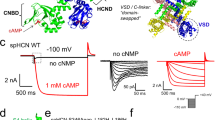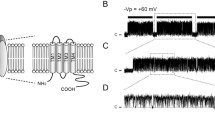Abstract
We used the whole cell patch clamp technique to investigate the characteristics of modification of cardiac Na+ channel gating by the sea anemone polypeptide toxin anthopleurin-A (AP-A). Guinea pig ventricular myocytes were isolated enzymatically using a retrograde perfusion apparatus. Holding potential was −140 mV and test potentials ranged from −100 to + 40 mV (pulse duration 100 or 1000 ms). AP-A (50–100 nM) markedly slowed the rate of decay of Na+ current (I Na) and increased peak I Na conductance (g Na) by 38±5.5% (mean±SEM, P < 0.001, n = 12) with little change in slope factor (n = 12) or voltage midpoint of the g Na/V relationship after correction for spontaneous shifts. The voltage dependence of steady-state I Na availability (h ∞) demonstrated an increase in slope factor from 5.9±0.8 mV in control to 8.0±0.7 mV after modification by AP-A (P < 0.01, n = 14) whereas any shift in the voltage midpoint of this relationship could be accounted for by a spontaneous time-dependent shift. AP-A-modified I Na showed a use-dependent decrease in peak current amplitude (interpulse interval 500 ms) when pulse duration was 100 ms (−15±2%, P < 0.01, n = 17) but showed no decline when pulse duration was 100 ms (−3±1%). This use-dependent effect was probably the result of a decrease in the rate of recovery from inactivation caused by AP-A which had a small effect on the fast time constant of recovery (from 4.1±0.3 ms in control to 6.0±1.1 ms after AP-A, P < 0.05) but increased the slow time constant from 66.2±6.5 ms in control to 188.9±36.4 ms (P< 0.002, n = 19) after exposure to AP-A. Increasing external divalent cation concentration (either Ca2+ or Mg2+) to 10 mM abolished the effects of AP-A on the rate of I Na decay. These results demonstrate that modification of cardiac Na+ channels by AP-A markedly slowed I Na inactivation and altered the voltage dependence of activation; these alterations in gating characteristics, in turn, caused an increase in g Na presumably by increasing the number of channels open at peak I Na. AP-A slows the rate of recovery of I Na from inactivation which is probably the basis for a use-dependent decrease in peak amplitude. Finally, AP-A binding is sensitive to external divalent cation concentrations. Thus, increasing [Mg2+]o or [Ca2+]o displaces AP-A from binding, suggesting that they share related binding sites on the external surface of the Na+ channel.
Similar content being viewed by others
References
Barhanin J, Hugues M, Schweitz H, Vincent JP, Lazdunski M (1981) Structure-function relationships of sea anemone toxin II from Anemonia sulcata. J Biol Chem 256:5764–5769
Beress L, Ritter R, Ravens U (1982) The influence of rate of electrical stimulation on the effects of the Anemonia sulcata toxin ATX II in guinea pig papillary muscle. Eur J Pharmacol 79:265–272
Bergman C, Dubois JM, Rojas E, Rathmayer W (1976) Decreased rate of sodium conductance inactivation in the node of Ranvier induced by a polypeptide toxin from sea anemone. Biochem Biophys Acta 455:173–184
Bezanilla F, Armstrong CM (1977) Inactivation of sodium channels. I. Sodium current experiments. J Gen Physiol 70:549–566
Brill DM, Wasserstrom JA (1986) Intracellular Na and the positive inotropic effect of veratridine and cardiac glycoside in sheep Purkinje fibers. Circ Res 58:109–119
Brill DM, Fozzard HA, Makielski JC, Wasserstrom JA (1987) Effect of prolonged depolarizations on twitch tension and intracellular sodium activity in sheep cardiac Purkinje fibers. J Physiol (Lond) 348:355–375
Catterall WA (1980) Neurotoxins that act on voltage-sensitive sodium channels in excitable membranes. Annu Rev Pharmacol Toxicol 20:15–43
Catterall WA (1988) Structure and function of voltage-sensitive ion channels. Science 242:50–61
Clarkson CW, Follmer CH, TenEick RE, Hondeghem LM, Yeh JZ (1988) Evidence for two components of sodium channel block by lidocaine in isolated cardiac myocytes. Circ Res 63:869–878
El-Sherif N, Fozzard HA, Hanck DA (1992) Dose-dependent modulation of the cardiac sodium channel by the sea anemone toxin ATXII. Circ Res 70:285–301
Fernandez JM, Fox AP, Krasne S (1984) Membrane patches and whole-cell membranes: A comparison of electrical properties in rat clonal pituitary (GH3) cells. J Physiol (Lond) 356:565–585
Follmer CH, TenEick RE, Yeh JZ (1987) Sodium current kinetics in cat atrial myocytes. J Physiol (Lond) 384:169–197
Hashimoto K, Ochi R, Hashimoto K, Inui J, Miura Y (1980) The ionic mechanism of prolongation of action potential duration of cardiac ventricular muscle by anthopleurin-A and its relationship to the inotropic effect. J Pharmacol Exp Ther 215:479–485
Holloway SF, Wu CH (1983) Modification of single sodium channels by sea anemone toxin ATX-II. Soc Neurosci Abstr 9:674
Huang L-Y M, Yatani A, Brown AM (1987) The properties of batrachotoxin-modified cardiac Na channels, including state-dependent block by tetrodotoxin. J Gen Physiol 90:341–360
Isenberg G, Ravens U (1984) The effects of the Anemonia sulcata toxin (ATX II) on membrane currents of isolated mammalian myocytes. J Physiol (Lond) 357:127–149
Katzung BG (1982) Myocardial toxicity as the result of altered membrane channel function. In: Van Stee EM (ed) Cardiovascular toxicology. Raven, New York, pp 135–179
Khodorov BI (1985) Batrachotoxin as a tool to study voltagesensitive sodium channels of excitable membranes. Prog Biophys Mol Biol 45:57–148
Low PA, Wu CH, Narahashi T (1979) The effect of anthopleurin-A on crayfish giant axon. J Pharmacol Exp Ther 210:417–421
Mitra R, Morad M (1985) A uniform enzymatic method for dissociation of myocytes from hearts and stomachs of vertebrates. Am J Physiol 249:H1056-H1060
Reuter H, Seitz N (1968) The dependence of calcium efflux from cardiac muscle on temperature and external ion composition. J Physiol (Lond) 195:451–470
Romey G, Abita JP, Schweitz H, Wunderer G, Lazdunski M (1976) Sea anemone toxin: A tool to study molecular mechanisms of nerve conduction and excitation-secretion coupling. Proc Natl Acad Sci USA 73:4055–4059
Sakakibara Y, Wasserstrom JA, Furukawa T, Jia H, Arentzen CE, Hartz RS, Singer DH (1992) Characterization of the sodium current in single human atrial myocytes. Circ Res 71:535–549
Scriabine A, Van Arman CG, Morgan G, Morris AA, Bennett CD, Bohidar NR (1979) Cardiotonic effects of anthopleurin-A, a polypeptide from a sea anemone. J Cardiovasc Pharmacol 1:571–583
Shibata S, Norton TR, Izumi T, Matsuo T, Katsuki S (1976) A polypeptide (AP-A) from sea anemone (Anthopleura xanthogrammica) with potent positive inotropic action. J Pharmacol Exp Ther 199:298–309
Shimizu T, Iwamura N, Toyama J, Yamada K, Shibata S (1979) Effect of cardiotonic polypeptide anthopleurin-a on canine Purkinje and ventricular muscle fibers. Eur J Pharmacol 56:7–13
Vassilev PM, Scheuer T, Catterall WA (1988) Identification of an intracellular peptide segment involved in sodium channel inactivation. Science 241:1658–1661
Vincent JP, Balerna M, Barhanin J, Fosset M, Lazdunski M (1980) Binding of sea anemone toxin to receptor sites associated with gating system of sodium channel in synaptic nerve endings in vitro. Proc Natl Acad Sci USA 77:1646–1650
Warashina A, Fujina S, Satake M (1981) Potential-dependent effects of sea anemone toxins and scorpion venom on crayfish giant axon. Pflügers Arch 391:273–276
Wasserstrom JA, Kelly JE, Liberty KN (1992) Modification of cardiac Na+ channels by anthopleurin-A increases sensitivity to lidocaine block. Biophys J 61:A305
Wasserstrom JA, Liberty KN, Kelly JE, Santucci P, Myers MK (1993) Modification of cardiac Na+ channels by batrachotoxin (in press)
Author information
Authors and Affiliations
Rights and permissions
About this article
Cite this article
Wasserstrom, J.A., Kelly, J.E. & Liberty, K.N. Modification of cardiac Na+ channels by anthopleurin-A: effects on gating and kinetics. Pflügers Arch. 424, 15–24 (1993). https://doi.org/10.1007/BF00375097
Received:
Revised:
Accepted:
Issue Date:
DOI: https://doi.org/10.1007/BF00375097




